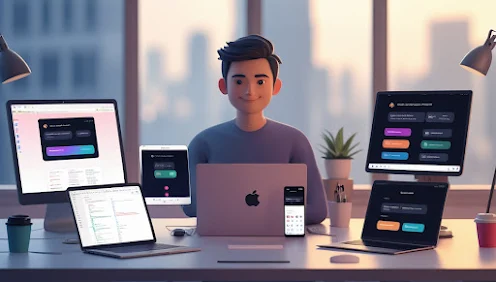Build beautiful apps for Web, Android, and iOS with Flutter from a single codebase! एक ही कोडबेस से Flutter में Web, Android और iOS के लिए शानदार ऐप्स बनाएं!
📘 Table of Contents
-
Introduction
-
Why Flutter for Web, Android, and iOS?
-
Setting Up Your Flutter Environment
-
Creating a Responsive Design in Flutter
-
Building for Android
-
Building for iOS
-
Building for Web
-
Tips for Debugging and Optimising Performance
-
Publishing to Google Play Store and Apple App Store
-
Deploying Flutter Web to Firebase Hosting
-
Expert Views and Best Practices
-
Final Thoughts
-
Disclaimer
🧩 1. Introduction
In today’s multi-platform world, having a mobile application is not enough. Businesses and developers want to run the same app on Android, iOS, and the Web, reducing development costs and reaching a wider audience. Flutter, Google’s UI toolkit, enables this through a single codebase and beautiful, natively compiled apps.
In this blog post, we will walk through how to build, test, and release Flutter apps for Web, Android, and iOS using best practices and a responsive design approach. This guide will also provide SEO-optimised tips, code examples, and expert opinions to help you succeed in your Flutter development journey.
🌐 2. Why Flutter for Web, Android, and iOS?
Flutter is not just a mobile SDK—it is a complete cross-platform solution. According to Statista, Flutter is one of the most popular frameworks in 2025 for app development.
🔍 Long-Tail Keywords Covered:
-
Why use Flutter for multi-platform development
-
Benefits of Flutter for web and mobile
-
Cross-platform mobile app development using Flutter
✅ Key Benefits:
-
Single codebase for all platforms
-
Fast development using Hot Reload
-
Beautiful UI with Material and Cupertino widgets
-
Access to device features using plugins
-
Strong community and Google backing
🛠️ 3. Setting Up Your Flutter Environment
🔧 Prerequisites:
-
Install Flutter SDK
-
Install Android Studio or VS Code
-
Setup Xcode (for iOS builds)
-
Chrome browser for Web builds
📦 Commands to check setup:
flutter doctor
This command shows missing dependencies. Make sure all are resolved before continuing.
🖥️ 4. Creating a Responsive Design in Flutter
Responsive UI is essential to ensure your app looks good across devices.
📱 Step-by-Step Guide:
📌 Step 1: Use LayoutBuilder and MediaQuery
Widget build(BuildContext context) {
return LayoutBuilder(
builder: (context, constraints) {
if (constraints.maxWidth > 600) {
return WebLayout();
} else {
return MobileLayout();
}
},
);
}
📌 Step 2: Use MediaQuery for spacing
double screenWidth = MediaQuery.of(context).size.width;
📌 Step 3: Use flutter_screenutil or responsive_framework package
dependencies:
flutter_screenutil: ^5.8.4
In your main.dart:
ScreenUtilInit(
designSize: const Size(360, 690),
builder: () => MyApp(),
);
💡 Expert Tip:
“Don’t just scale widgets. Plan for different layouts. A good responsive app isn’t stretched—it’s restructured.”
– Andrea Bizzotto, Flutter GDE
🤖 5. Building for Android
✅ Steps:
-
Set your app name and ID in
android/app/build.gradle. -
Generate a release keystore.
-
Update
key.properties.
flutter build apk --release
To generate App Bundle:
flutter build appbundle
🗒️ Google Play Optimisation Keywords:
-
How to build release APK in Flutter
-
Flutter app bundle for Google Play
🍏 6. Building for iOS
🔐 Steps:
-
Open project in Xcode.
-
Add your Apple Developer Account.
-
Setup certificates and provisioning profiles.
-
Update
Info.plistand icons.
flutter build ios --release
⚠️ Note:
iOS builds require macOS and Xcode.
🌍 7. Building for Web
✅ Steps:
-
Enable web support (if not already):
flutter config --enable-web
-
Run the web app:
flutter run -d chrome
-
Build web release:
flutter build web
📁 Output: Located in /build/web/
🧪 8. Tips for Debugging and Optimising Performance
-
Use
flutter analyzeto detect code issues. -
Use
DevToolsfor memory and performance profiling. -
Minify web JS with:
flutter build web --release --dart2js-optimization=O2
-
Use lazy loading, compress images, and optimise network calls.
📤 9. Publishing to Google Play Store and Apple App Store
🔍 Steps to Publish on Google Play:
-
Prepare your app for release.
-
Upload
.aabfile to Play Console. -
Fill in details (title, description, screenshots).
-
Submit for review.
🔍 Steps to Publish on Apple App Store:
-
Archive app via Xcode.
-
Upload to App Store Connect.
-
Complete metadata.
-
Submit for review.
📸 Tools:
-
AppIcon.co – create app icons.
-
Screenshots.cloud – create app screenshots.
🔥 10. Deploying Flutter Web to Firebase Hosting
🧭 Step-by-Step:
-
Install Firebase CLI:
npm install -g firebase-tools
-
Login to Firebase:
firebase login
-
Initialise project:
firebase init
-
Set public directory as
build/web -
Deploy:
firebase deploy
🧠 11. Expert Views and Best Practices
📌 Expert Opinions:
-
Chris Sells (Flutter PM at Google):
-
Felix Angelov (Creator of Bloc):
✔️ Best Practices:
-
Use feature flags for platform-specific code
-
Test across multiple screen sizes
-
Avoid platform-exclusive APIs unless required
-
Use CI/CD tools like GitHub Actions or Codemagic
🏁 12. Final Thoughts
Building for Web, Android, and iOS using Flutter allows developers to reduce duplication, save cost, and deliver a consistent user experience. By following responsive design principles, optimising builds, and deploying with proper tooling, you can release high-quality apps across platforms.
Whether you're an individual developer or part of a team, this complete guide offers the foundation for successful cross-platform Flutter development.
⚠️ 13. Disclaimer
Disclaimer:
While I am not a professional Flutter developer or UI/UX expert, I have thoroughly
researched this topic using official Flutter documentation, expert opinions,
and industry best practices to compile this guide. This post aims to provide
helpful insights and practical examples to support your learning journey.
However, for advanced or complex Flutter projects, seeking advice from
experienced developers is always recommended to ensure best results.
Your suggestions and views on Flutter responsive design are welcome—please share below!
Previous Post 👉 CI/CD for Flutter with GitHub Actions or Codemagic
Next Post 👉 Managing App Versioning and Rollouts in Flutter


